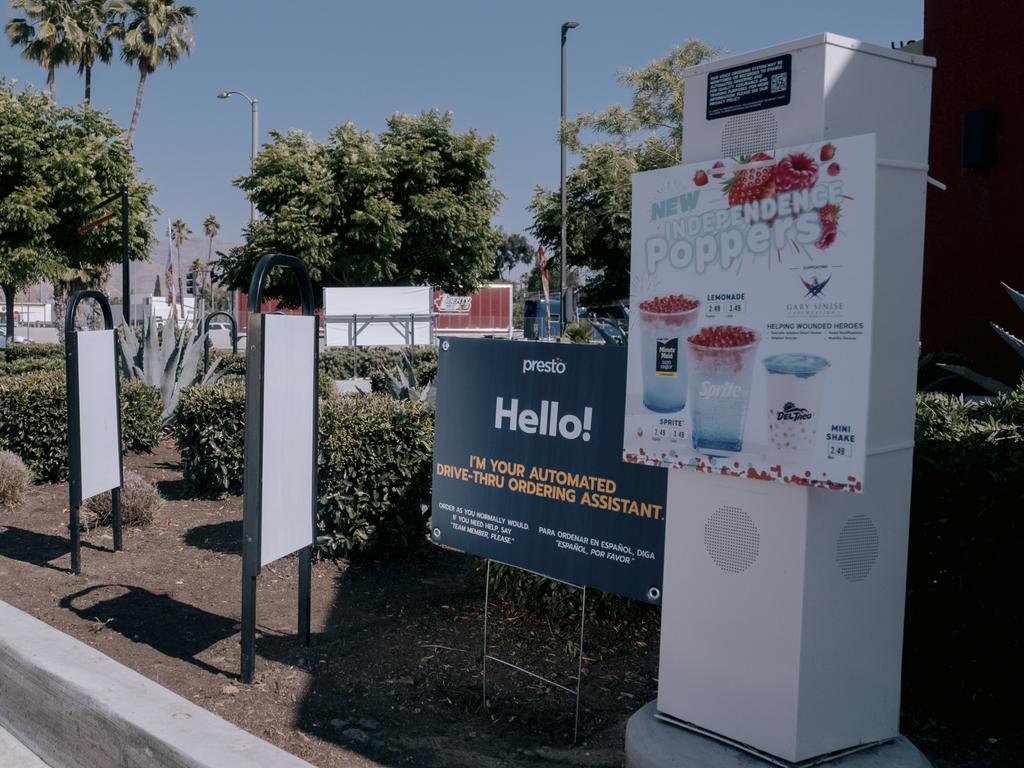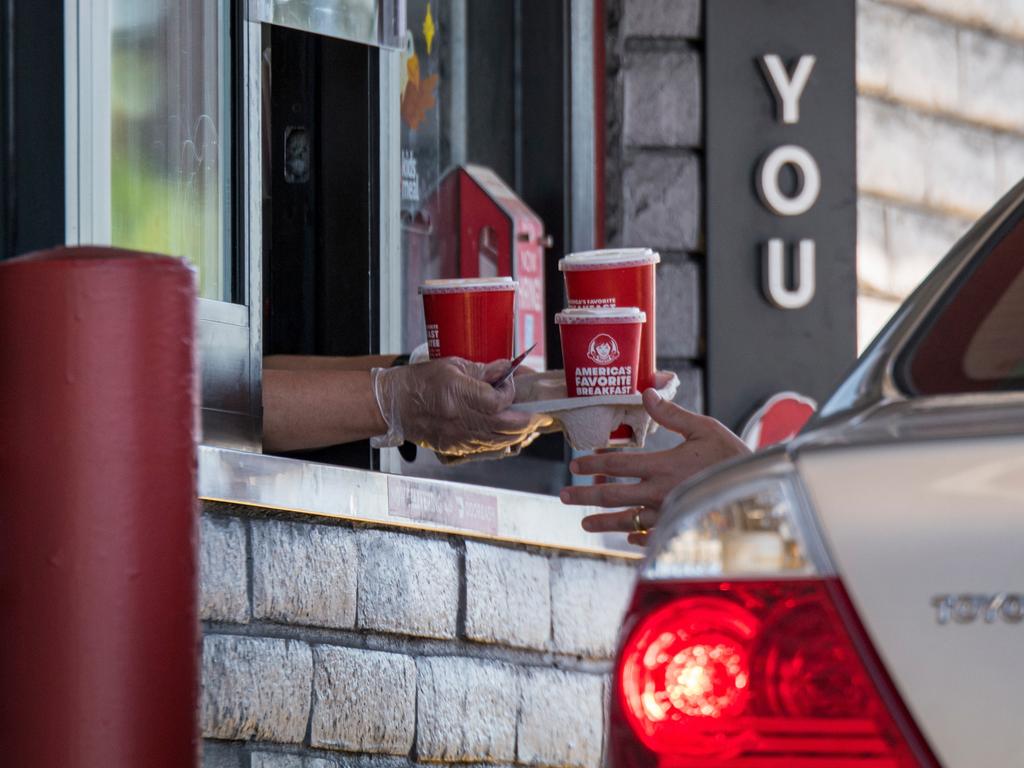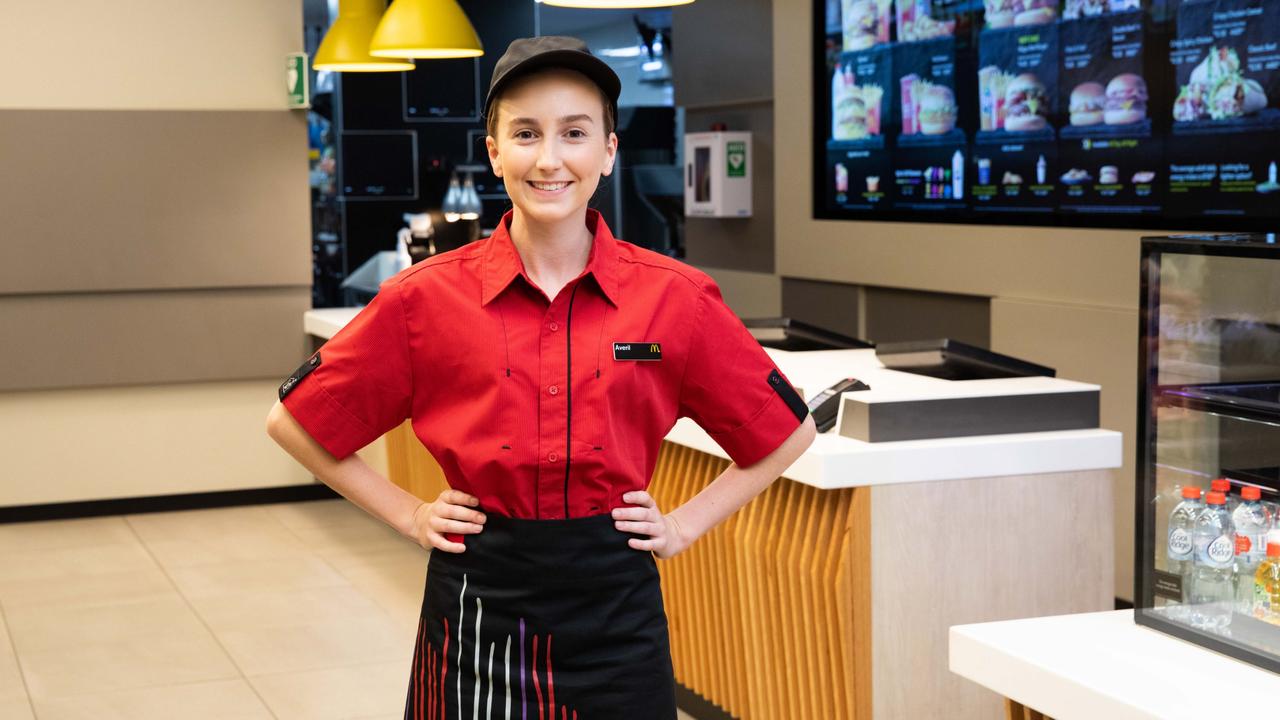The robots aren’t coming for your jobs – they’re already here taking them, starting with fast food
A video of a chilling interaction between a drive-through customer and a ‘worker’ shows what’s coming to Australia any day now. Here’s why it’s bad news.
A major fast-food chain has replaced drive-through workers with artificial intelligence software and a video of a customer’s encounter with the new tech has gone viral.
In the eerie TikTok, a woman films herself approaching the menu of a Wendy’s restaurant in the US and ordering a dessert from an AI, which successfully completes the task from start to finish in less than 30 seconds.
The company is one of several major operators in America, alongside McDonald’s, Chipotle, Domino’s and Taco Bell, to sign contracts with technology providers.
Economists forecast millions of fast-food jobs will be lost in the coming five years as smart kiosks replace humans.
“Within five to 10 years, I think the majority of positions within restaurants can be automated,” Valyant AI founder Rob Carpenter told Fox News.
And the technology is predicted to be operating in Australia within the year, displacing countless people from jobs often relied on to make ends meet.
The beginning of mammoth change
Niusha Shafiabady, an associate professor in Charle Darwin University’s Faculty of Science and Technology, and an expert in machine learning, intelligent modelling and systems design, said the chilling video is a sign of what’s to come.
“This is just the beginning of a major disruption,” Dr Shafiabady said, adding that society is approaching the point where mass-replacement “really accelerates”.
“It’s reasonable to expect this kind of trend to spread into other sectors or professions, including engineering, healthcare, even in my profession of coding.
“The World Economic Forum forecasts administration and secretarial-type jobs to be displaced relatively quickly, while the World Bank says people in the lowest 40 per cent of income distribution are the ones likely to lose their jobs to technology quite quickly.”
Jobs that are relatively easy to replace with AI, like fast-food workers, will be “among the first to go”, she said.

Ros Cameron is the director of the Centre for Organisational Change and Agility at Torrens University Australia and said the mass rollout of this kind of consumer-facing technology is “inevitable”.
“And it’s a double-edged sword,” Professor Cameron said.
“Obviously this technology improves efficiencies and productivity, but it will come at the cost of workers. Fast food outlets are where high school students, uni students, the semi-skilled get employment and work experience.
“For many, these are usually survival jobs. It’s where they get their first experiences within a workplace and learn a lot of really important skills.
“For some, they’ll have two or three of these sorts of casual jobs that they’re juggling just to make ends meet.”
Hundreds of millions of jobs
Professor Cameron said she feels for a certain socio-economic group within the community who are “really going to lose out” by the rollout of this technology.
“The unskilled, the semi-skilled who rely on these types of jobs, will be displaced. And so, we might create a bigger gap between those with skills and qualifications and those without. That’s a very scary proposition for our society.”
There’s good reason for people to be alarmed at the potential consequences – and not just those working in fast-food restaurants.
Analysis released last year by Goldman Sachs predicted AI will replace the equivalent of 300 million full-time jobs globally in coming years.

The financial giant expects 46 per cent of tasks in administrative roles and 44 per cent of legal profession duties could be automated by AI.
“Analysing databases detailing the task content of over 900 occupations, our economists estimate that roughly two-thirds of occupations [in the US] are exposed to some degree of automation by AI,” the report read.
“They further estimate that, of those occupations that are exposed, roughly a quarter to as much as half of their workload could be replaced.”
On the flip side, just six per cent of construction tasks and four per cent of maintenance duties could be replicated by machine.
But few workers can afford to be complacent, Dr Dr Shafiabady said.
“Any job that can be replicated by a program is definitely at risk and would be replaced relatively fast.”
Research suggests that technologies developed since the 1980s have displaced workers at a faster pace than they have created new job opportunities.
Should that trend pan out with AI, Goldman Sachs concedes there will be near-term job losses in a variety of fields.

That kind of scenario would be great for businesses and their bottom lines, but would there be many, if any benefits for society?
“It’s a very good question that I’m also pondering,” Dr Shafiabady said.
“Employment is at the heart of economies. Imagine that 40 per cent or 50 per cent of the population loses their jobs in the next five years. That work is directly connected to the health of the economy.
“It would be a disaster. Just think about what happened [globally] during the pandemic when many people lost their jobs or were displaced. There were major impacts.”
Mass job losses in a short space of time would fundamentally alter “the structure of economies, communities and society”, she warned.
“Are we willing to move in that direction or not? That’s the question that should be addressed now, I believe.”
Expect this tech in Australia
Many commenters on the TikTok seemed to view the human-replacing AI through a somewhat dystopian lens.
Those watching from Australia who think the rollout of similar technology in drive-throughs here should expect to see it sooner rather than later.
David Tuffley, senior lecturer in the School of Information and Communication Technology at Griffith University, believes it could land within the year.
“We’ll see this technology in Australia, without doubt,” Dr Tuffley said.
“Australia watches carefully what goes on in the US. We tend to watch and evaluate, and when the bugs have been ironed out, we adopt.
“I don’t think it’s going to be all that long. Probably in the coming year, we’ll start to see it being piloted somewhere, trialled for a couple of months, and then probably rolled out across the country within two to three years.
“That’s just an educated guess, but these technologies mature pretty fast and when there’s a financial incentive to do it, it generally does happen very quickly.”

There are multiple drivers of financial benefits for companies that adopt this kind of technology, Dr Tuffley explained.
As well as reducing headcount, and thus slashing costs on hiring, training and retaining staff, the technology has been proven to be exceptionally good at sales.
“For a start, AI is always cheerful, friendly and eager to help,” he said.
“There’s also big potential for personalisation down the track. I think we might see AI getting to know individuals. There would be ways of sort of recognising people. There would be cameras on the car and face recognition, and it could say, ‘Hi Jim, do you want your usual?’
“That’s obviously a tricky issue with privacy concerns and whatnot, but those kinds of applications could improve convenience and time.
“Upselling is also a big plus for businesses. So, if it’s a hot day, before the person even says what they want at the window, the AI might say suggest a cold drink or ice cream or some other relevant product.
“Maybe it’s a new product that people don’t know about yet and it would be just perfect for a day like that.”
Analysis by Valyant found that well-trained human staff can upsell customers in the drive-through about 50 per cent of the time, on average.
“Valyant upsells about 200% on average,” Mr Carpenter told Fox News.
‘Do we want this?’
So far, governments around the world seem optimistic about the potentials on offer, saying AI can drive productivity across the economy.
Britain’s Technology Secretary Michelle Donelan last year told The Sun that workers in the United Kingdom had more reasons to be excited than fearful.
“We want to make sure that AI is complementing the way we work in the UK, not disrupting it – making our jobs better, rather than taking them away,” Ms Donelan said.
Experts are less relaxed about the potential downsides of a rapid rollout of AI technology that replaces human workers.
“My personal belief – this is just my opinion – is that governments should start thinking about these major changes and coming up with policies,” Dr Shafiabady said.
“How much do they want to allow this change to occur?”

In Australia, the rapid uptake of AI and machine learning in the workplace prompted Minister for Employment and Workplace Relations Tony Burke to last month order a parliamentary inquiry.
The Inquiry into the Digital Transformation of Workplaces is being chaired by Labor MP Lisa Chesters, who said the committee will examine “the intersection between advanced digital technology and the labour market”.
“Australian workplaces are changing the way they operate,” Ms Chesters said.
“The committee wants to understand what these changes mean for employees and employers, our workplaces and the way we regulate and govern our employment practices.”
Public submissions are open until June 21.
Joseph Mitchell, assistant secretary of the Australian Council of Trade Unions, said workers’ voices should be at the heart of discussions about how emerging technologies are adopted.
“There should be no decision about us without us,” Mr Mitchell said.
“AI is already being used at many workplaces across the country and is already impacting how we work. Workers’ rights and living standards must be protected through technology adoption and we won’t accept any erosion of the rights we have.
“Further, if AI increases productivity, those benefits must be shared with workers.”
While this type of technology will inevitably replace many jobs, Professor Cameron believes it will increase opportunities too.
“There will be more jobs in tech,” she said.
“You’ve got to be educated, get those qualifications and skill sets. I think policy-wise, the government really needs to push micro-credentials courses, small courses, vet courses, higher ed courses, to encourage people – especially from low socio-economic backgrounds – to gain some skills that are going to grow and are going to have growth within them.




